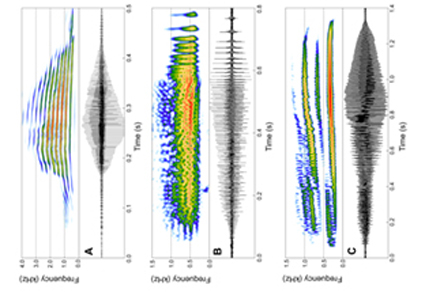References
- Bioacoustics Research Program (2024) Raven Pro: Interactive Sound Analysis Software. Version 1.6.5. The Cornell Lab of Ornithology, Ithaca, New York, Computer software. Available from: https://ravensoundsoftware.com/ (accessed 25 June 2024)
- Bokermann, W.C.A. (1959) Una nueva especies de Leptodactylus de la region Amazonica (Amphibia, Salientia, Leptodactylidae). Neotropica, 5, 5–8.
- Cochran, D.M. & Goin, C.J. (1959) A new frog of the genus Limnomedusa from Colombia. Copeia, 1959, 208–210.
- https://doi.org/10.2307/1440389
- Cocroft, R.B. & Ryan, M.J. (1995) Patterns of advertisement call evolution in toads and chorus frogs. Animal Behaviour, 49, 283–303. https://doi.org/10.1006/anbe.1995.0043
- Ferrão, M., Fraga, R.D., Simões, P.I. & Lima, A.P. (2014) On the poorly sampled Amazonian frogs genus Hydrolaetare (Anura: Leptodactylidae): geographic ranges and species identification. Salamandra, 50, 77–84.
- Figueiredo, V.M., Calado, J.F., Arraes, D.R.S., Cantuária, P.C., Tavares-Pinheiro, R., Pinheiro-Freitas, A. & Costa-Campos, E. (2021) Defensive behavior of Hydrolaetare schmidti (Cochran & Goin, 1959) (Anura: Leptodactylidae). Herpetology Notes, 14, 965–967.
- Gallardo, J.M. (1963) Hydrolaetare, nuevo género de Leptodactylidae (Amphibia) neotropical. La Plata, 9, 42–48.
- Gridi-Papp, M. (2008) The structure of vocal sounds produced with the mouth closed or with the mouth open in treefrogs. Journal of the Acoustical Society of America, 123, 2895–2902. https://doi.org/10.1121/1.2897001
- Guerra, M.A., Ryan, M.J. & Cannatella, D.C. (2014) Ontogeny of sexual dimorphism in the larynx of the túngara frog, Physalaemus pustulosus. Copeia, 2014, 123–129. https://doi.org/10.1643/CG-13-051
- Hödl, W. & Gollmann, G. (1986) Distress calls in Neotropical frogs. Amphibia-Reptilia, 7, 11–21. https://doi.org/10.1163/156853886X00226
- Jansen, M., Gonzales-Álvarez, L. & Köhler, G. (2007) New species of Hydrolaetare (Anura, Leptodactylidae) from Bolivia with some notes on its natural history. Journal of Herpetology, 41, 724–732. https://doi.org/10.1670/06-289.1
- Lescure, J. & Marty, C. (2000) Atlas des amphibiens de Guyane. Patrimoines Naturels, 45, 1–388.
- Ligges, U., Krey, S., Mersmann, O. & Schnackenberg, S. (2017) tuneR: analysis of music and speech. Available from: https://CRAN.R-project.org/package=tuneR (accessed 24 June 2024)
- Martin, W.F. (1971) Mechanics of sound production in toads of the genus Bufo: passive elements. Journal of Experimental Zoology, 176, 273–293. https://doi.org/10.1002/jez.1401760304
- Martins, M. & Haddad, C.F.B. (1988) Vocalizations and reproductive behaviour in the Smith Frog, Hyla faber Wied (Amphibia: Hylidae). Amphibia-Reptilia, 9, 49–60. https://doi.org/10.1163/156853888X00206
- Oliveira-Filho, A.T., Dexter, K.G., Pennington, R.T., Simon, M.F., Bueno, M.L. & Neves, D.M. (2021) On the floristic identity of Amazonian vegetation types. Biotropica, 53, 767–777. https://doi.org/10.1111/btp.12932
- R Core Team (2023) R: a language and environment for statistical computing. Version 4.3.1. R Foundation for Statistical Computing, Vienna. Available from: http://www.r-project.org (accessed 25 June 2024)
- Rodríguez, L.O. & Duellman W.E. (1994) Guide to the frogs of the Iquitos Region, Amazonian Peru. University of Kansas Natural History Museum Special Publication 22. University of Kansas Natural History Museum, Lawrence, Kansas, 80 pp.
- Sazima, I. (1975) Distress call in newly metamorphosed smith frog, Hyla faber Wied. Herpetologica, 31, 471–472.
- Souza, M.B. & Haddad, C.F.B. (2003) Redescription and reevaluation of the generic status of Leptodactylus dantasi (Amphibia, Anura, Leptodactylidae) and description of its unusual advertisement call. Journal of Herpetology, 37, 490–497. https://doi.org/10.1670/259-01A
- Sueur, J., Aubin, T. & Simonis, C. (2008) Seewave: a free modular tool for sound analysis and synthesis. Bioacoustics, 18, 213–226. https://doi.org/10.1080/09524622.2008.9753600
- Toledo, L.F. & Haddad, C.F.B. (2009) Defensive vocalizations of Neotropical anurans. South American Journal of Herpetology, 4, 25–42. https://doi.org/10.2994/057.004.0104
- Toledo, L.F., Martins, I.A., Bruschi, D.P., Passos, M.A., Alexandre, C. & Haddad, C.F.B. (2015) The anuran calling repertoire in the light of social context. Acta Ethologica 18, 87–99. https://doi.org/10.1007/s10211-014-0194-4
- Wells, K.D. (1977) The social behaviour of anuran amphibians. Animal Behaviour, 25, 666–693. https://doi.org/10.1016/0003-3472(77)90118-X
- Wells, K.D. (2007) The Ecology and Behavior of Amphibians. The University of Chicago Press, Chicago, Illinois, 1148 pp.


